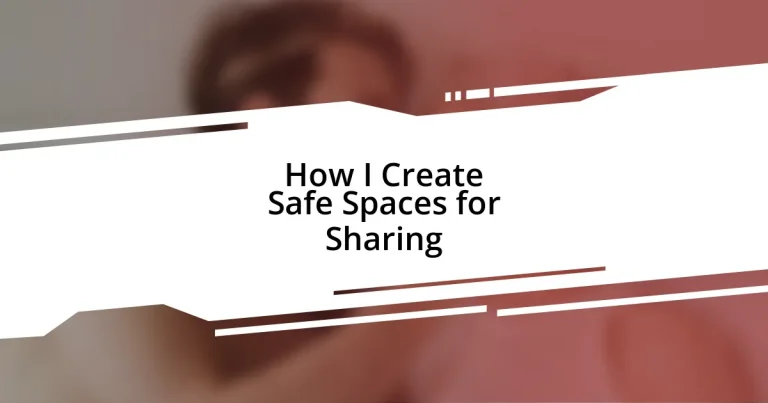Key takeaways:
- Safe spaces promote emotional safety, allowing individuals to share vulnerabilities and create deeper connections.
- Psychological safety fosters open communication, innovation, and learning from mistakes, strengthening team dynamics.
- Establishing flexible ground rules and practicing active listening, like reflecting and asking open-ended questions, enhances engagement.
- Encouraging vulnerability and openness through transparency and shared experiences deepens trust and fosters community.

Understanding Safe Spaces
Safe spaces are environments where individuals feel accepted and valued, allowing for open and honest dialogue without fear of judgement. I remember attending a workshop focused on mental health; the moment I sensed the room’s supportive energy, it was like a weight lifted off my shoulders. Isn’t it amazing how a simple change in atmosphere can make us feel so secure?
Creating these spaces involves much more than just physical location; it’s about fostering emotional safety. I often reflect on the times I’ve stumbled through difficult conversations, only to find that sharing my vulnerabilities sparked deeper connections. Have you ever found that being open about your struggles invites others to do the same? It’s a powerful reminder that our shared human experiences can bridge gaps and create understanding.
To truly understand safe spaces, we must acknowledge diverse perspectives and experiences. I recall moments when a friend shared their story of discrimination; it broke my heart, but it also opened my eyes to the reality many face. This empathy drives home the idea that everyone deserves a place where their voice is heard—how can we contribute to making these inclusive environments a part of our daily interactions?

The Importance of Psychological Safety
Psychological safety is essential because it allows individuals to express themselves without the fear of repercussion or humiliation. I once sat in a team meeting where a colleague hesitated to share their innovative idea, worried it might be criticized. When someone else finally voiced the value in taking risks, I saw my colleague visibly relax. It’s moments like these that highlight how an open environment encourages creativity and authentic contributions.
Here are some key reasons why psychological safety matters:
- Encourages Open Communication: People are more likely to share their thoughts and ideas when they feel respected and valued.
- Fosters Innovation: A safe atmosphere nurtures creativity, as individuals aren’t held back by the fear of failure.
- Strengthens Team Bonds: When team members feel comfortable being vulnerable, trust and camaraderie flourish.
- Promotes Learning from Mistakes: In a psychologically safe space, mistakes are seen as opportunities for growth rather than grounds for punishment.

Establishing Ground Rules for Sharing
Establishing ground rules for sharing is crucial when creating a safe space. I’ve found that clearly outlining expectations helps everyone feel more comfortable participating. For instance, in a recent discussion group, we crafted rules emphasizing respect and active listening. These simple guidelines transformed our conversation into a space of trust and openness, allowing every voice to be heard.
It’s important to remember that ground rules shouldn’t be rigid; they can evolve as the group dynamics change. Reflecting on my experiences, I’ve learned that encouraging participants to contribute to the guidelines fosters a sense of ownership. I once facilitated a session where everyone took turns suggesting rules based on their comfort levels. The result was a collaborative environment where sharing felt less daunting.
When laying down rules, balance is key. While it’s essential to establish boundaries, I often remind participants to remain flexible and compassionate. I recall a time when a member accidentally interrupted someone, and instead of reprimanding them, we gently reminded ourselves of the importance of patience. This approach not only maintained the safe space but also highlighted our humanity—perfection isn’t the goal; connection is.
| Traditional Ground Rules | Evolving Ground Rules |
|---|---|
| Strictly enforced | Flexible and adaptable |
| Set by the facilitator | Co-created by all participants |
| Focus on compliance | Emphasis on understanding |

Active Listening Techniques for Engagement
Active listening is more than just hearing words; it’s about tuning into the emotions and intentions behind them. One technique I often use is reflecting back what someone has said. This isn’t just repetition; it’s a way of showing that I genuinely value their message. I remember a heartfelt conversation with a friend who was struggling, and as I repeated her thoughts back, I saw relief wash over her face. It was as if my echo gave her validation and space to explore her feelings further.
Another effective approach is asking open-ended questions. This invites a deeper dialogue and lets others know that their voice matters. For example, during a team brainstorming session, I once asked, “What might be a fun approach to tackle this challenge?” This simple question opened the floodgates of creativity, and before I knew it, everyone was contributing their unique ideas, transforming our meeting from mundane to inspirational.
Lastly, body language plays a crucial role in active listening. When I engage with someone, I make a conscious effort to maintain eye contact, nod, and lean slightly forward. It signals my interest and encourages the speaker to share more openly. I recall attending a workshop where the facilitator’s enthusiastic posture ignited excitement in the room, making us all feel like we were part of something larger. It’s these subtle yet powerful cues that can enhance engagement and foster a deeper sense of connection in any conversation.

Role of Empathy in Conversations
Empathy is the heart of meaningful conversations. When I engage with someone, it’s my ability to connect with their feelings that sets the tone for openness. I once had a heart-to-heart with a colleague going through a tough time. Instead of giving advice, I simply shared, “I can’t imagine how hard this must be for you,” and saw their shoulders relax. That moment made me realize how much power genuine empathy holds.
Being empathetic means truly immersing oneself in another’s experience. It’s not just about what we say but how we make the other person feel. For instance, during a group discussion where emotions ran high, I chose to pause and validate each person’s feelings. By saying things like, “It’s completely understandable to feel that way,” I noticed a shift in the room. It was like a wave of relief washed over everyone, and the dialogue transformed into a more collaborative exchange of thoughts.
I often wonder, how can we show empathy without feeling overwhelmed by someone else’s emotions? From my experience, it all comes down to practice and intention. I’ve found that when I approach conversations with the mindset of curiosity rather than judgment, empathy flows more naturally. Remembering that every person carries their own story allows us to build a bridge of understanding, and honestly, those are the moments that stick with me long after the conversation ends.

Encouraging Vulnerability and Openness
Creating a welcoming atmosphere for vulnerability invites deeper connections. I recall hosting a small gathering where I encouraged everyone to share a personal story. As one friend spoke about their struggles with anxiety, I could see the weight lift as they shared their truth. It surprised me how just that space transformed the energy in the room, prompting others to open up. Have you ever noticed how shared vulnerability can create an invisible thread of trust among a group? It’s a powerful revelation.
I also prioritize transparency in my interactions. When I express my own uncertainties, it disarms the tension and normalizes the experience of being human. For example, during a team meeting, I openly admitted my lack of experience in a project area. Suddenly, colleagues who might have stayed quiet felt comfortable sharing their own doubts. This openness didn’t just foster dialogue; it reminded us that we’re all on this journey together, and that is incredibly freeing.
Encouraging vulnerability isn’t solely about allowing others to speak. It’s about modeling the behavior ourselves. I often think back to a mentoring session where I opened up about my past failures. Rather than diminishing my credibility, it actually sparked a lively discussion. This raises a compelling question—what are we afraid of by being vulnerable? When I finally acknowledged my imperfections, I found that others followed suit, leading to richer conversations. It’s in those moments of shared humanity that we truly connect and learn from one another.

Sustaining Safe Spaces Over Time
Sustaining safe spaces requires ongoing commitment and active effort. I remember a time when I facilitated a workshop where participants agreed to check in with each other regularly. That simple commitment transformed our group dynamic over time; it wasn’t just about the workshop itself but the shared responsibility of continuing the dialogue beyond our initial meetings. Have you ever participated in something similar that made you feel part of a community?
It’s important to adapt and evolve these spaces as relationships deepen. In one of my own experiences, I noticed a shift in our group’s needs after several months. We started with general check-ins, but as trust solidified, we needed deeper discussions about our challenges and aspirations. By being attuned to these changes, I was able to foster a more enriching environment. How do you keep your ear to the ground for the evolving dynamics in your community?
Lastly, I believe acknowledging and celebrating progress plays a crucial role in maintaining momentum. I often take time at the end of our meetings to highlight individual contributions and the ways we’ve grown together. This not only reinforces that everyone’s voice matters but also encourages ongoing participation. Reflecting on our journey reminds me—what milestones have you celebrated that reignited your passion for a project or community? Those moments can spark a renewed sense of safety and belonging in a space we’ve collectively crafted.














